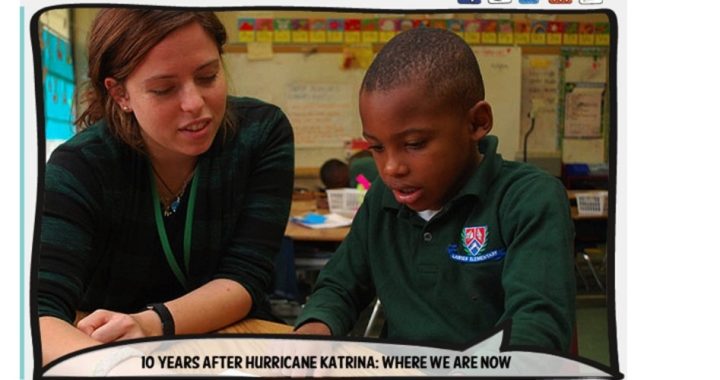
Before Hurricane Katrina damaged or destroyed more than 100 of New Orleans’ 128 public schools in August 2005, Cohen College Prep (CCP) was one of the worst-performing schools in the city, with very few students graduating and fewer still being accepted into college. In the aftermath CCP was turned into a charter school, and now almost 100 percent of its students not only graduate but are accepted into college.
Results like this, appearing all across New Orleans’ charter schools, are leading many to conclude that this is Katrina’s “silver lining.”
Prior to Katrina,123 of those 128 schools were operated by Orleans Parish School Board (OPSB), with decidedly dismal results. Only 12 of those schools showed “reasonably good performance,” according to researchers. Katrina overwhelmed the OPSB, forcing them to announce the indefinite closure of all schools in the city. In November 2005, the Louisiana legislature passed laws transferring 102 of the city’s worst-performing schools to the Recovery School District, which had been created in 2003 to take over the very worst of the worst of the failing schools. Five of them had already been transferred before Katrina hit.
Under the direction of Paul Vallas, the Recovery School District was on its way to becoming the first “all-charter” school district in the United States. By eliminating teachers unions and the traditional educational bureaucracy, while giving each school’s administration the power to hire and fire teachers, set education parameters, and establish disciplinary standards, and allowing parents to choose among various schools, their students began to learn.
And their test scores began to reflect that learning. Improvements were noted as early as October 2009 when an all-school performance score showed a 24-percent improvement from 2004.
As the Christian Science Monitor noted in March 2014:
Gone is the traditional central district office that assigns students to schools, hires and promotes teachers in negotiation with a union, and controls everything from budgets to textbooks.
Instead, families here choose among charter schools citywide that — in exchange for their autonomy — have to meet certain benchmarks in order to have their charters renewed.
Test scores and graduation rates have climbed steadily.
One measure of student performance is the Growth School Performance Score, which is based on a number of factors including test scores and graduation rates. Prior to Katrina, only one in eight students attending New Orleans’ public schools attended “A” or “B”- rated schools, while nearly three out of four attended “F”-rated schools. By 2013, just one in six were still attending “F’-rated schools, while a third were attending “A” or “B”-rated schools.
Another measure was the percentage of students qualifying for college scholarships after graduating from high school. Prior to Katrina, less than six percent of students received scholarships. In 2013, 27 percent did.
It’s clear that getting rid of the traditional educational bureaucracy and especially the teachers unions removed a major impediment to students’ learning. Allowing families to choose where to send their kids also helped, along with local administrations working in a competitive marketplace to keep those families happy by selecting and establishing local educational and behavioral standards. As Michael Stone, a spokesman for a pro-charter school group New Schools for New Orleans, expressed it: “While there’s still a long way to go, on the whole the schools are unequivocally better.”
And Shannon Faulstick, the parent of a daughter in one of New Orleans’ charter schools, said:
It’s not a perfect system, but it is better. If my daughter had to go to the schools in our neighborhood, we couldn’t do it. Those are failing schools and now we have a choice on where [she can] go.
But although many believe that charter schools are generally better than the typical public schools, particularly with regard to academic rigor, many also warn that charter schools are still bankrolled by tax dollars and under the authority of government, which will ultimately advance its interests — or the interests of those who control government decision-making — as opposed to the interests of parents. Changes in government policies and practices may change the better charter schools for the worse, just as has occurred over the decades with public education in general. This is particularly the case if government is allowed to extend its control over, or regulate into oblivion, private education.
“It is important to note the dangers of charter schools — namely, the crowding out of private schools and bringing all education under government control,” Alex Newman warned this writer. Newman, who himself is a regular contributor to The New American, is also a high school teacher and the coauthor (with Samuel Blumenfeld) of Crimes of the Educators: How Utopians Are Using Government Schools to Destroy America’s Children.
Newman pointed out that the threat of the charter schools taking their curriculum, and their students, down a slippery slope is very real. “This has already happened in countries such as Sweden,” he noted, “where government-funded private schools must now teach the government’s controversial curriculum, and we are even seeing this in some areas of the United States.”
Newman also told this writer: “Because charter schools are funded by taxpayers, they generally have to obey the mandates and dictates of feds, politicians, and the education bureaucracies on everything from Common Core to using quack ‘whole-word’ or ‘look-say’ methods of teaching reading that result in life-long reading handicaps for countless students. While they may sometimes be slightly better than standard government schools, that is not saying much, and we need to be constantly vigilant. A vibrant ecosystem of private, religious and home schools is essential, and to the extent that charter schools tend to undermine this, they must be opposed.”
A graduate of an Ivy League school and a former investment advisor, Bob is a regular contributor to The New American magazine and blogs frequently at www.LightFromTheRight.com, primarily on economics and politics.



